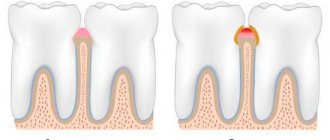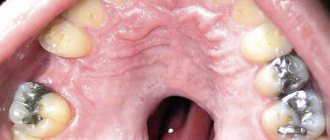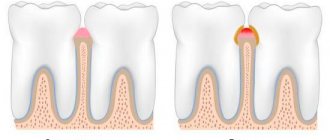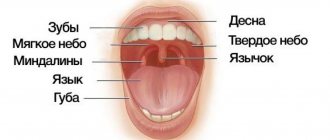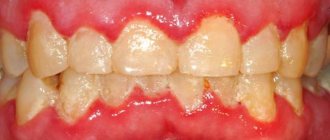Acute herpetic stomatitis
This is an infectious viral disease that occurs in response to primary contact with the herpes simplex virus.
Infection occurs
- by airborne droplets;
- through contact and household means (through toys, dishes, etc.);
- from persons suffering from recurrent herpes.
Children aged 6 months to 3 years are most often affected.
Main signs of the disease:
redness of the oral mucosa and blisters appear, which quickly open and form multiple painful round ulcers (erosions), bleeding gums; increased body temperature, general weakness, intoxication; the child eats and sleeps poorly.
To prevent the spread of infection
a child with acute herpetic stomatitis is not allowed to visit a child care facility, even if the disease occurs in a very mild form.
Prevention of infection with the herpes simplex virus upon contact with sick people involves lubricating the mucous membrane of the nose and mouth with 0.25% oxolinic ointment for 5 days.
If there are signs of disease, you should consult a pediatric dentist!
Diseases of the oral mucosa in children
Thursday, March 4, 2021
The oral mucosa is constantly exposed to a variety of irritants - chemical, mechanical, thermal, numerous microbial agents and toxins. In addition, the oral cavity is a sensitive indicator, showing the state of the internal organs and promptly signaling the presence of problems in one or another body system.
The structure of the child's oral mucosa is a target for various pathogens. There is a common name for inflammatory diseases of the oral mucosa - stomatitis.
Stomatitis in children can be associated with various reasons:
1.traumatic origin; 2. for childhood infections: for example, measles, chickenpox; herpetic stomatitis, staphylococcal lesions; 3. stomatitis caused by a specific infection (candidiasis, thrush); 4. stomatitis caused by allergies (reaction to environmental allergens, food products, medications); due to pathologies of other organs and systems of the child’s body; diseases of the mucous membrane of the tongue and lips in a child (usually considered separately). Diagnosis and treatment of diseases of the oral mucosa in children requires an individual approach to the child. Local treatment is carried out by pediatric dentists (primary diagnosis, pain relief, prevention and treatment of secondary infection, etc.). Doctors of other specialties (pediatricians, gastroenterologists, allergists, endocrinologists, immunologists) are also involved.
Prevention of diseases of the oral mucosa in children.
Stomatitis most often occurs in children under 5 years of age. When preventing stomatitis in children, it is necessary to take into account that some types of infectious forms (acute herpetic stomatitis) are easily transmitted from sick children and adults. Therefore, it is necessary to maintain hygiene (disinfection of premises), wash toys, and prevent dirt or infection from getting into the child’s mouth. General prevention consists of therapy with vitamin preparations (as recommended by a doctor), which strengthen the immune defense of the child’s body.
A characteristic manifestation of stomatitis is the appearance on the oral mucosa of foci of redness, blisters, erosions (afts) or ulcers covered with plaque. These lesions are most often detected on the mucous membrane of the cheeks, floor of the mouth, hard palate, and tip of the tongue.
Often there is pain at the location of erosions and ulcers, enlargement of nearby lymph nodes, and sometimes an increase in body temperature.
At the first symptoms of stomatitis, you should consult a dentist. In this case, you should not self-medicate. After all, depending on the type of disease, the doctor prescribes specific treatment. Prevention consists, first of all, in strengthening the child’s immunity - maintaining a proper sleep and rest schedule, carrying out water procedures, and a nutritious and balanced diet. Hygiene standards should be observed: clean toys and utensils, do not lick pacifiers and spoons when feeding the baby. Avoid contact with children and adults who have signs of herpes infection. Correctly select, store and change toothbrushes in a timely manner.
The task of parents, from the appearance of the child’s first teeth, medical workers, and kindergarten teachers, is to teach the child to maintain oral and hand hygiene.
Nutrition for stomatitis.
It is difficult for a child with stomatitis to eat, so before eating it is better to treat the oral mucosa with an anesthetic prescribed by the doctor.
Food should be warm, liquid consistency
Eliminate salty and sour foods, limit sweets
Let your child drink more and more often (up to 1.5 liters of liquid per day in the form of jelly, fruit drinks)
BASIC REQUIREMENTS FOR CARE OF A CHILD WITH DISEASE OF THE ORAL MUCOSA:
1. Be sure to maintain oral hygiene (brush your teeth and wipe the mucous membrane of the mouth, cheeks, tongue with a weak solution of hydrogen peroxide - a tablespoon in half a glass of water).
2. The diet should be rich in proteins (broths, milk, cream).
3.Frequent medicinal treatment of the oral cavity (10-12 times a day).
4. Ventilation of the room, sanitary treatment of toys.
5. Compliance with quarantine for up to 10 days.
6.When body temperature normalizes, use air baths.
7.Follow all prescriptions of the attending physician.
Thrush (acute candidiasis)
In infancy, the epithelium of the oral mucosa is very thin, so a fungal infection, when salivary immunity decreases, very easily attaches to the surface of the mucosa. Symptoms of thrush At the first stage of the disease, red spots appear. They can be found on the tongue, mucous membrane of the cheeks, lips and gums. After a few days, white cheesy rashes appear in place of the red areas. They look like the remains of cottage cheese or kefir in a child's mouth. The white plaque is difficult to separate, and the wounds that are opened begin to bleed and bacteria from the oral cavity enter them, which can lead to various complications. Thrush in the mouth is painful. Because of this, children refuse to eat, cannot swallow saliva, and become restless. If you discover a manifestation of the disease, you should consult a doctor and only then begin treatment for oral thrush in children. In severe cases of the disease, the temperature rises, the baby becomes lethargic, and symptoms of intestinal diseases appear. Treatment depends on the extent of the disease.
Prevention of thrush Follow the rules of hygiene for children: bathe your baby regularly, boil nipples, bottles, toys. Strengthen your child's immunity with walks in the fresh air, vitamins from fresh vegetables and fruits, therapeutic massage and, of course, love your baby, give him enough time and attention and then he will grow up healthy.
Do not try to treat your child yourself!
Treatment of stomatitis in children should be carried out by a pediatric dentist!
Chronic recurrent aphthous stomatitis
This is a chronic inflammatory disease of the oral mucosa of a non-infectious nature, characterized by periodic exacerbations and remissions.
Causes of the disease:
- allergic reactions in a child;
- diseases of the gastrointestinal tract;
- respiratory infections;
- functional disorders of the central and autonomic nervous system;
- chronic inflammatory diseases of the nasopharynx (otitis, sinusitis, etc.)
School-age children and adolescents are more often affected.
Main signs of the disease:
on the mucous membrane of the oral cavity (usually lips, cheeks, transitional folds of the upper and lower jaws, the lateral surface and back of the tongue) one or several areas of redness with rounded painful aphthae covered with a yellowish coating appear; the child’s general condition may deteriorate, the child refuses to eat; healing occurs with adequate treatment after 5-7 days without a scar.
In order to prevent exacerbations of the disease, it is necessary:
- regular visits to the dentist (at least 2 times a year);
- elimination of foci of chronic infection in the oral cavity (treatment of carious teeth and periodontal diseases);
- systematic hygienic oral care.
If there are signs of disease, you should consult a pediatric dentist!
Fluoridation of baby teeth.
In childhood, caries progresses rapidly. This often leads to tooth loss. Fluoridation takes place at the white spot stage, this helps to avoid the penetration of the disease inside.
The composition of the preparation for fluoridation of teeth includes silver fluoride diamine. Crystals of silver phosphate and calcium fluoride prevent the entry of pathogenic microorganisms and also inhibit the activity of microbes. Process:
Tooth enamel affected by caries is carefully cleaned of plaque, then the drug is applied. This method allows you to avoid too violent a reaction from a small patient. Treatment usually takes place in 3-4 procedures every 6 months.
Sign up for fluoridation
Candidiasis (thrush)
This is a fungal disease that occurs as a result of the proliferation of fungi of the genus Candida on the oral mucosa.
Transmission of a fungal infection to a child is possible:
- during passage through the birth canal of a mother suffering from candidomycosis;
- through contact and household means (through pacifiers, underwear and other items for caring for the newborn).
Weak children in the first weeks of life are more likely to get sick.
Main signs of the disease:
the disease begins asymptomatically, and then the child becomes restless, eats and sleeps poorly. Regional lymph nodes may be enlarged, body temperature is normal, but may also be elevated, a plaque in the form of white dots appears in the oral cavity on the mucous membrane of the cheeks along the line where the teeth meet; on the palate, lips, and tongue; As the fungus multiplies, the plaque increases in size, forming a film resembling curdled milk.
In order to prevent the occurrence of the disease, it is necessary to promptly treat thrush in women during pregnancy and maintain a healthy gastrointestinal tract in a young mother; observe sanitary and hygienic measures in maternity hospitals and at home, sterilize pacifiers and bottle nipples.
Prevention
in children is the timely detection and treatment of dysbiosis, and with long-term prescription of antibiotics - timely administration of probiotics.
If there are signs of disease, you should consult a pediatric dentist!
Caries of baby teeth
Many children are limited in their access to sweets, mistakenly assuming: “If there are no sweets, there will be no tooth decay.” However, caries also appears for other reasons:
- improper or insufficient oral hygiene;
- infection by pathogenic organisms;
- genetic predisposition;
- taking medications.
Just like in adults, caries in children is divided into three main stages:
- Caries in the initial stage is a spot.
The disease at this stage is practically asymptomatic. The affected tooth does not respond to stimuli, external damage is invisible.
- Middle stage caries.
At this stage, bad breath appears. A noticeable carious spot appears on the affected area.
- Deep stage caries.
The carious stain spreads faster and faster, and the color of the teeth changes. When exposed to any irritants, acute pain appears, which goes away immediately after the irritants disappear.
Caries of primary teeth has the following features:
- Symptoms may not appear for a long time;
- a child may become vulnerable to caries due to infectious diseases;
- there is a low level of mineralization;
- defeat is possible immediately after teething.
They use a method of treating the affected tooth by blowing it with a mixture of special powder and air.
Sign up for caries treatment
Afta Bednara
This is an inflammatory disease of the oral mucosa of a non-infectious nature, occurring in weak, bottle-fed infants in the first months of life.
Causes of the disease:
- permanent mechanical injury to the mucous membrane of the palate due to a nipple that is too long and too hard;
- may occur in breastfed children if the mother's nipple is very rough.
Main signs of the disease:
round or oval erosions, covered with loose plaque and located symmetrically at the border of the hard and soft palate, redness of the surrounding mucous membrane. The child becomes restless, eats and sleeps poorly.
In order to prevent the occurrence of the disease, it is necessary
promptly replace the pacifier or pacifier if irritation occurs on the oral mucosa.
If there are signs of disease, you should consult a pediatric dentist!
If any changes appear on the oral mucosa, you should visit a pediatric dentist to avoid complications and conduct a comprehensive examination and treatment!!!
Treatment of caries of primary teeth
Children under 4 years of age are treated with dental fluoridation at the staining stage. Children are often afraid of the sound of a working dental unit, and try in every way to interfere with the doctor. In such cases, there is an alternative to drilling the tooth. A small amount of a special substance is injected into the carious cavity, which softens the pathological mass of caries, after which the doctor cleans the tooth with a hand instrument, then inserts a filling.
They use a method of treating the affected tooth by blowing it with a mixture of special powder and air. This method of treating children's teeth without drilling does not cause pain or anxiety for young patients.
Sign up for caries treatment
Intestines in children, child
The intestines in children are relatively longer than in adults. The cecum is mobile due to the long mesentery, so the appendix can be located in the right iliac region, displaced into the small pelvis and into the left half of the abdomen, which creates difficulties in diagnosing appendicitis in young children (examination by a pediatric surgeon at the Markushka polyclinic). The sigmoid colon is relatively long, which predisposes children to constipation, especially if the mother's milk contains high amounts of fat. The rectum in children in the first months of life is also long, with weak fixation of the mucous and submucosal layer, and therefore, with tenesmus and persistent constipation, it may prolapse through the anus. The mesentery is longer and more easily stretchable, which can lead to torsion, intussusception and other pathological processes. A feature of the intestines in children is the better development of circular muscles than longitudinal ones, which predisposes to intestinal spasms and intestinal colic. A feature of the digestive organs in children is also the poor development of the lesser and greater omentum, therefore an infectious process in the abdominal cavity (appendicitis, etc.) often leads to diffuse peritonitis.
The intestinal secretory apparatus is generally formed by the time the child is born; the intestinal juice contains the same enzymes as in adults, but their activity is low. Under the influence of intestinal enzymes, mainly the pancreas, the breakdown of proteins, fats and carbohydrates occurs. However, the pH of duodenal juice in young children is slightly acidic or neutral, so the breakdown of protein by trypsin is limited (for trypsin, the optimal pH is alkaline). The process of fat digestion is especially intense due to the low activity of lipolytic enzymes. In breastfed children, bile-emulsified lipids are broken down by 50% under the influence of mother's milk lipase.
Digestion of carbohydrates occurs in the small intestine under the influence of pancreatic amylase and intestinal juice disaccharidases.
The structural features of the intestinal wall and its large area determine in young children a higher absorption capacity than in adults and, at the same time, an insufficient barrier function due to the high permeability of the mucous membrane to toxins and microbes.
Liver in children, child
The liver in children is relatively large, in newborns it makes up about 4% of body weight (in adults - 2% of body weight). In young children, bile formation is less intense than in older children. The bile of children is poor in bile acids, cholesterol, lecithin, salts and alkali, but rich in water, mucin, pigments and urea, and also contains more taurocholic acid than glycocholic acid (taurocholic acid is an antiseptic). Bile neutralizes acidic food gruel, which makes the activity of pancreatic and intestinal secretions possible. In addition, bile activates pancreatic lipase, emulsifies fats, dissolves fatty acids, turning them into soaps, and enhances peristalsis of the large intestine.
Esophagus, stomach in a child, children
The esophagus in young children has a funnel shape. Its length in newborns is 10 cm, with age it increases, and the diameter of the esophagus becomes larger. At the age of up to one year, physiological narrowing of the esophagus is weakly expressed, especially in the area of the cardiac part of the stomach, which contributes to frequent regurgitation of food in children of the 1st year of life.
The stomach in infants is located horizontally, its bottom and cardiac region are poorly developed, which explains the tendency of children in the first year of life to regurgitate and vomit.
As the child begins to walk, the axis of the stomach becomes more vertical, and by the age of 7-11 it is located in the same way as in an adult. The stomach capacity of a newborn is 30-35 ml, by the age of one year it increases to 250-300 ml, and by the age of 8 it reaches 1000 ml.
The secretory apparatus of the stomach in children of the 1st year of life is not sufficiently developed; they have fewer glands in the gastric mucosa than adults, and their functional abilities are low. Although the composition of gastric juice in children is the same as in adults (hydrochloric acid, lactic acid, pepsin, rennet, lipase), the acidity and enzymatic activity are lower, which determines the low barrier function of the stomach and a different pH of the gastric juice (4-5 ; in adults 1.5-2.2). In this regard, proteins are not sufficiently broken down in the stomach by pepsin (they are broken down mainly by cathepsins and gastricsin, produced by the gastric mucosa). Gastric lipase (produced by the pyloric part of the stomach) breaks down in an acidic environment, together with human milk lipase, up to half of the fats in human milk. These features must be taken into account when prescribing different types of food to a child .
The digestive system in children, child. Generalization
The digestive system in children is distinguished by a number of anatomical and physiological features that affect the functional ability of these organs. A child in the first year of life has a relatively greater need for food than older children. Although the child has all the necessary digestive enzymes, the functional capacity of the digestive organs is limited and can only be sufficient if the child receives physiological food, namely human milk. Even small deviations in the quantity and quality of food can cause digestive disorders in an infant (they are especially common in the 1st year of life) and ultimately lead to retarded physical development.
The act of defecation in children, child
The act of defecation in infants occurs reflexively without the participation of a volitional moment, and only by the end of the first year of life does defecation become voluntary.
In the first hours and days of life, a newborn excretes original feces, or meconium, in the form of a thick, odorless, dark olive-colored mass. Subsequently, the feces of a healthy infant have a yellow color, an acidic reaction and a sour smell, and their consistency is mushy. At an older age, the stool becomes formed. The frequency of stool in infants is from 1 to 4-5 times a day, in older children - 1 time a day.

